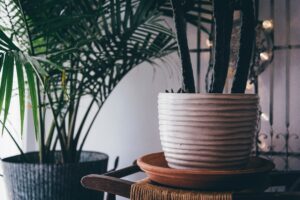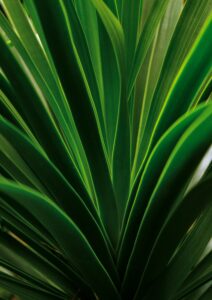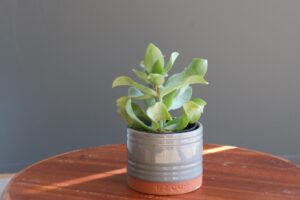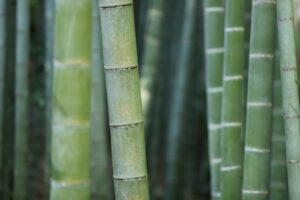Majesty Palm Care
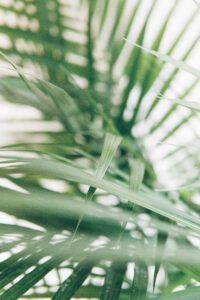
Majesty Palm Care
The Majesty Palm, also known as the Ravenea rivularis, is a tropical palm tree that is native to Madagascar. It is a popular indoor and outdoor plant due to its elegant and striking appearance. The Majesty Palm can grow up to 30 feet tall in its natural habitat, but when grown in pots, it typically reaches between 6 and 8 feet tall.
Ravenea rivularis, the majestic palm, or majesty palm, is a species of tree in the family Arecaceae. They generally grow to 10 to 12 feet tall and are often marketed in stores as a “houseplant” in a pot, in its natural state, the majesty palm may sometimes grow to 98 feet (30 meters) tall.
The palm has upward-arching leaves divided into long, thin fingers. It is native to Madagascar; however, it is believed only about 900 plants are currently alive in the wild according to an assessment conducted in 2010. The species grows in several regions of Madagascar, but because those regions are totally surrounded and separated by desert, the natural spread of the species is limited. Despite its fragility as a species in the wild, it has become a very popular houseplant due to its beautiful leaves and slow-growing nature.
Adult Ravenea Rivularis, Florida USA
Ravenea rivularis grows in somewhat isolated humid habitats that are found in the otherwise dry, hot semi-arid climate of southwest Madagascar. Often, they grow huddled along the edges of riverbanks and natural lagoons, but also grow in shallow swamps where they receive ample water and humidity year-round. Due to its love for warm, moist air which can be difficult to provide consistently in most homes, the most common problem affecting those kept as houseplants is browning leaf tips. To replicate its natural growing conditions, plants should be misted with warm water daily or kept near a humidifier. It should also be watered more frequently than average houseplants especially in the spring and summer. That being said, fast-draining soil is preferable, such as soil labeled for cacti, in a well-draining container to allow water to seep through the root system and out of the pot. Although they can also suffer from lack of sunlight, Ravenea rivularis is much more sensitive to lack of water and humidity.
Majesty palms are often sold as cheap lush tropical foliage house plants but are hard to take care of for long term survivability.
In addition to ample water, Ravenea rivularis kept as a houseplant requires specialty fertilizer for palm trees which contains more magnesium than all-purpose fertilizers. Slow-release palm fertilizer with an NPK ratio of about 8-2-12 with at least 4% magnesium is ideal. A pinch of epsom salt may also be used as an alternative source of magnesium.
The leaves of the Majesty Palm are large and feathery, reaching up to 4 feet long. They are a glossy green color and are arranged in a graceful arching pattern. The trunk of the palm is slender and smooth, with a gray-brown color. The tree produces small, insignificant flowers that are followed by small, round berries.
The Majesty Palm prefers a well-draining soil that is rich in organic matter. It prefers a warm and humid environment, making it an ideal plant for a greenhouse or a conservatory. It can also be grown outdoors in tropical and subtropical climates.
When grown indoors, the Majesty Palm prefers bright, indirect light, and should be kept away from direct sunlight. It also prefers high humidity, so regular misting or placing a tray of water near the plant can help to maintain the necessary moisture levels.
The Majesty Palm is relatively low maintenance, but it does require regular watering and fertilization. It is also important to prune off any yellow or brown leaves as they appear, to keep the plant looking healthy and tidy.
Overall, the Majesty Palm is a beautiful and striking plant that can add a touch of elegance to any indoor or outdoor space. With proper care and maintenance, it can thrive for many years and become a cherished addition to any garden or home.
What Kind of Fertilizer for a Majesty Palm?
Palms are the kind of plant that does not go unnoticed in the landscape. Majesty palm (Ravenea rivularis) is a symmetrical, feather-leaved variety introduced from the rainforests of Madagascar. It is hardy in U.S. Department of Agriculture plant hardiness zones 9 through 11, but is commonly grown as a houseplant in colder climates. Like other palms, it has exacting fertilizer requirements that are not met by generic, all-purpose fertilizers.
Nutrient Needs
Most garden centers sell fertilizer products formulated specifically for palm trees and these are perfect for majesty palms. These differ from most other fertilizers because the manufacturer includes magnesium, along with other trace elements. The ideal palm fertilizer has 8 percent nitrogen, 2 percent phosphorus, 12 percent potassium and 4 percent magnesium – these are indicated with the numbers 8-2-12-4 printed on the bag. Make sure to use slow-release fertilizers only.
Outdoor Fertilizer Application
Fertilize majesty palms planted in the ground every two months between April and September, for a total of three applications per year. Spread the fertilizer evenly over the root zone of the plant at a rate of 1.5 pounds of granular fertilizer for every 100 square feet of surface area. Spread the fertilizer on the ground in an area that corresponds to the size of the canopy, at a minimum. However, the roots of large majesty palms can extend far beyond the canopy, so spread the fertilizer to twice the size of the canopy on mature specimens.
Lawns and Palms
One challenge in growing majesty palms outdoors is the negative effects of lawn fertilizer on nearby palm trees. Lawn fertilizers have a high ratio of nitrogen to potassium that causes a nutritional imbalance in palms. Plus, they contain little or no magnesium, which is necessary for palm health. However, palm fertilizer can effectively meet the nutrient needs of lawn grass. As a general rule, use only palm fertilizer within 30 feet of the trunk of majesty palms – it will not harm grasses and other plants in the vicinity.
Potted Majesty Palms
Fertilize potted palms in a slightly different manner than plants in the ground; this holds true for the majesty palm as well. Potted palms need a higher proportion of nitrogen – use a liquid fertilizer labeled 18-6-12 for best results. The potting mix usually will supply magnesium in the form of dolomite, though the initial quantity may last only six months. You can repot majesty palm each year, or add dolomite at a rate of 1 pound per cubic foot of potting soil each year. Apply a slow-release liquid fertilizer every three months to potted palms.
It is, however, a somewhat tricky plant to grow successfully indoors, requiring humid air, lots of bright indirect light, and consistent moisture. It is often referred to by houseplant experts as a “challenging” plant.
When grown indoors, majesty palm will add about one foot of growth per year until it reaches four to six feet, then slows down dramatically. It is faster-growing as an outdoor plant where its roots are free to roam—it is occasionally used as a landscape tree in California, South Florida, and other tropical regions.
Types of Majesty Palm
There are no named cultivars of Ravenea rivularis. There are only about 20 species in the Ravenea genus, all of them considered seriously endangered. R. rivularis is the only species commonly cultivated for garden or houseplant use.
Pruning
Pruning duties are generally limited to simply removing any fronds that have turned brown or yellow. This is all that’s needed to keep the plant looking good.
Propagating Majesty Palm
Majesty palms are raised exclusively from seed, and commercial production of seeds is somewhat limited. It’s highly unlikely that home growers can get access to seeds. Propagation through stem cuttings is also not an option. However, division, or separating the offset “pups” from the mother palm, is a viable option. This method is best done when you need to repot the plant so the plant is not stressed by moving it around too much. Here are the steps for division:
Remove the plant from its pot by gently rolling it out of the container while it’s on its side. Do not yank the palm from its pot from an upright position.
Look for pups, or offshoots, from the mother plant that you can potentially separate from the root ball.
Massage the root ball with your fingers to relax and soften it so you can untangle the pups. To help separate roots, use a disinfected, sharp knife if needed. You can even trim the roots of the pups if they are too long for new pots.
Place offshoots in pots with fast-draining soil. Water the pots in a sink until it starts to drip from the bottom, but do not let the pot sit in water.
Put pots in a bright spot, like its mother plant. Fertilize the baby palms in about a month.
Potting and Repotting Majesty Palm
This palm may need to be repotted annually, but more likely every other year since it grows slowly. When repotting, be careful not to damage the root ball and use a large, heavy container to prevent the palm tree from tipping over. Pots made from clay or ceramic will help stabilize these plants, which can get top-heavy.
A standard potting mix blended with additional peat moss works well as a growing medium.
In cold-winter regions, it’s quite common to move these plants back and forth between an outdoor patio and an indoor location as the seasons shift. Make sure to get your plant indoors before freezing weather arrives.
Overwintering
During the winter, a majesty palm likes a slightly cooler temperature, 55 to 65 degrees Fahrenheit. Otherwise, winter care remains the same.
About Salt Lake City, Utah
Salt Lake City is the capital and most populous city of Utah, United States. It is the seat of Salt Lake County, the most populous county in Utah. With a population of 200,133 in 2020, the city is the core of the Salt Lake City metropolitan area, which had a population of 1,257,936 at the 2020 census. Salt Lake City is further situated within a larger metropolis known as the Salt Lake City–Ogden–Provo Combined Statistical Area, a corridor of contiguous urban and suburban development stretched along a 120-mile (190 km) segment of the Wasatch Front, comprising a population of 2,746,164, making it the 22nd largest in the nation. It is also the central core of the larger of only two major urban areas located within the Great Basin.
Neighborhoods in Salt Lake City, Utah
Poplar Grove, The Avenues, Marmalade, Central City, Fairpark, Ballpark, Downtown, Capitol Hill, Woodbury, Neighborhood House, Rio Grande, The Neighborhood Hive, Rose Park Neighborhood Center, Neighborhood Services, Salt Lake City Community Development, University Neighborhood Partners, Airport East Business Park, Granary Row, Neighborhood Auto Service, Salt Lake City
Things To Do in Salt Lake City, Utah
Bus Stops in Salt Lake City, Utah to Truco Services, Inc.
Bus Stop in Greyhound: Bus Station Salt Lake City, Utah to Truco Services, Inc.
Bus Stop in Salt Lake Central Salt Lake City, Utah to Truco Services, Inc.
Bus Stop in Greyhound: Bus Stop Salt Lake City, Utah to Truco Services, Inc.
Bus Stop in Stadium Station (EB) Salt Lake City, Utah to Truco Services, Inc.
Bus Stop in South Salt Lake City Station Salt Lake City, Utah to Truco Services, Inc.
Bus Stop in 2100 S / 700 E (WB) Salt Lake City, Utah to Truco Services, Inc.
Bus Stop in Salt Lake Central Station (Bay A) Salt Lake City, Utah to Truco Services, Inc.
Bus Stop in 200 S / 1000 E (EB) Salt Lake City, Utah to Truco Services, Inc.
Bus Stop in South Salt Lake City Station Salt Lake City, Utah to Truco Services, Inc.
Bus Stop in 900 E / Wilson Ave (SB) Salt Lake City, Utah to Truco Services, Inc.
Bus Stop in Us Hwy 89 @ 270 S (N. Salt Lake) Salt Lake City, Utah to Truco Services, Inc.
Bus Stop in Courthouse Station Salt Lake City, Utah to Truco Services, Inc.
Driving Directions in Salt Lake City, Utah to Truco Services, Inc.
Driving Directions from Hidden Oak Tree Care to 4640 Commerce Dr, Murray, UT 84107, USA
Driving Directions from A Swedin Tree Expert to 4640 Commerce Dr, Murray, UT 84107, USA
Driving Directions from Atlas Tree Service to 4640 Commerce Dr, Murray, UT 84107, USA
Driving Directions from Diamond Tree Experts to 4640 Commerce Dr, Murray, UT 84107, USA
Driving Directions from Arbor+ to 4640 Commerce Dr, Murray, UT 84107, USA
Driving Directions from Integrated Tree Professionals to 4640 Commerce Dr, Murray, UT 84107, USA
Driving Directions from Urban Oaks Tree Service to 4640 Commerce Dr, Murray, UT 84107, USA
Driving Directions from Greenlite Tree Care to 4640 Commerce Dr, Murray, UT 84107, USA
Driving Directions from Heritage Tree Experts to 4640 Commerce Dr, Murray, UT 84107, USA
Driving Directions from Arborcare-Arborscape, Inc. to 4640 Commerce Dr, Murray, UT 84107, USA
Driving Directions from Arbornauts Tree Experts to 4640 Commerce Dr, Murray, UT 84107, USA
Driving Directions from Amen Trees to 4640 Commerce Dr, Murray, UT 84107, USA
Reviews for Truco Services, Inc. Salt Lake City, Utah
Marissa Burton
TruCo is a great company to work with for your commercial landscaping and snow removal needs! Rob is excellent to work with. He is very timely in providing quotes and has a lot of great feedback and suggestions to provide on what will look great, fit within your budget, and is knowledgeable on plants that will thrive with Utah's ever changing weather conditions. I have been impressed with TruCo's landscape maintenance as well as landscape projects which have had a quick turnaround time. I would highly recommend using TruCo!
Yvonne Olson
I experienced excellent all around service from landscape improvement design, scheduling and professional installation completed within the timeline we discussed. Rob, the manager does an excellent job of communicating, overseeing the install crew and making sure his customers are 100% satisfied with the job. Highly recommend TruCo for all landscaping needs.
Raymond Ferraro
Michael the tree guy is so smart. He knows all about tree removal, cutting and tree trimming services. Truco did amazing work for me. We had 16 very old and mature trees removed. The Truco team showed up on time ready to get the job done. They did amazing with clean up truly respect your property and your life. Communication was really good. They needed to move some things to get the stump grinder to our yard they put things back with no issues. Extremely professional and truly know what they're doing. If anyone is looking for professional tree removal or tree service you really should call Jason or Michael at Truco.
Heather Whiting
We hired TruCo to do a new install of sprinklers, sod, spigot, and bury downspouts. We even have a wifi transmitter for our control box we can access from an app on our phones! We absolutely love the professionalism and quality of their work!! Our sales rep Pete was the best to work with, we highly recommend him to anyone in the market for landscaping. It was awesome seeing the finished results and we're incredibly excited to enjoy our new space!
Jan Merideth
TruCo installed all of our plants, trees and shrubs, drip lines, and boulders. Then they installed our amazing beautiful firepit. We loved the results and they guarantee all plants and trees up to a year. They were great and easy to work with. They listened to our needs and wants and met them 100%. Our HOA sent us a letter telling us they appreciate all the work and the way our yard looks and let us know we added value to the property. Win/Win
